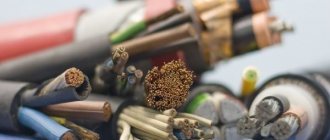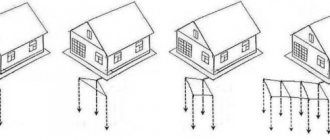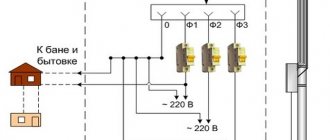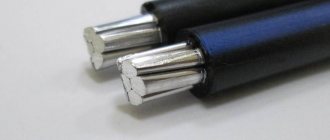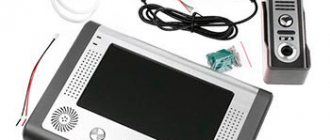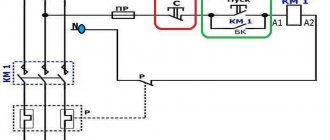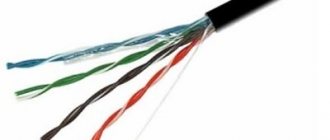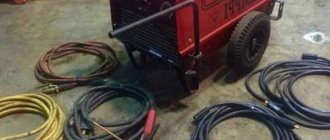To increase the power of the power grid in private homes, it is necessary to replace the wire. Therefore, we figure out what cable is needed to connect a house to a 15 kW electrical network. Let's consider which wire is best to use, how to introduce it into the house and what types there are. We will also decide what cable is needed for connection via air or ground, what should be the distance from the wire to the ground or other nearby objects.
Power supply input Source infoelectrik.ru
Connection rules
To introduce electricity into a house from a pole, the new rules for connecting which you need to know in order to comply with the law, you need to have the appropriate skills.
The standard power of the connected network for entering a house on private plots is 4-6 kW, but if the owner has permission to build an individual dwelling, then he has the right to connect to a 15 kW network. This is necessary for the convenience of using high-power electrical appliances.
The supply must be carried out according to a design that is made taking into account the technical conditions prescribed individually for the site. Therefore, to connect the electrical network with new power, you need to submit an application to the energy supply company and indicate the required power (15 kW) and voltage (230/400 V). These parameters can be obtained by calculating the total consumption of all electrical appliances.
In the new technical specifications, the supplier company must indicate the permitted power, the size of the cable cross-section, their brand and type, as well as the requirements for protection and connection of the power grid to the house.
Connection to the home Source domelectrik.ru
Independent connection without approval of the project and permission from the energy supplier will entail a fine, but choosing the type of connection and participating in the discussion of the selected materials is recommended for those who understand at least something about this. Laying aluminum cables is prohibited on structures that are susceptible to fire. Therefore, it is necessary to replace it with copper analogues.
The distance from the balcony is required to be from 1 m for insulated and from 1.5 m for bare cables, and from a blank wall - from 20 cm for protected and 1 m for uncoated wires. Also, uninsulated overhead power lines are prohibited from running over buildings for safety reasons.
It is important! Any actions with power lines must be carried out only when the required section is completely disconnected, as well as with the application of portable grounding.
Schematic determination of distance Source www.allremont59.ru
Who connects the house to electricity?
The owner of the house does not have the right to independently connect to the power line. The connection is carried out by the energy supply organization in whose department the house or plot is located. However, the energy company is responsible for connection and operation only outside the owner’s territory. So, for example, the points of connection to the network should not be more than 25 m from the boundaries of the site. In other words, if there is no power line running near the site, the energy supply organization is obliged to additionally bring it to the required distance. All work inside the site and the house must be performed by the owner. And the network company leaves a list of necessary measures and requirements for electrical equipment, which will be purchased and installed by the owner. All these instructions are specified in the Technical Specifications, which are issued to the owner or his representative after submitting an application and drawing up an agreement.
Types of cable for a 15 kW network
You need to know which cable to use to enter a private house: 3-phase or single-phase. Connecting using the first option implies reducing the load on the network and the rating of the input machine. The disadvantage is that the size of the distribution panel will be larger than with a single-phase connection, since the power switches will occupy 3-4 modules.
Also, three-phase residual current devices are larger in size. But this type of input cable makes it possible to connect asynchronous electrical devices, boilers, electric stoves or heating systems to the house.
Since the voltage in a three-phase network is 380 V, for protection you will need a three-way circuit breaker before entering the network into the house. It will help avoid the risk of fire and electric shock, and also provide protection against short circuits in the electrical network. Wires differ in the material from which the core is made. Copper cables have lower resistance than aluminum cables, but are more expensive.
Sectional view of 15 kW wire Source elektrik-a.su
Cables for power supply differ in the type of input:
- Airy . For this purpose, the AVK, SIP or AVVG (VVG) models are used. They have the ability to transmit current up to 1 kV and withstand temperatures from -50 to +48 ° C. The disadvantage of the air input is the use of jumpers necessary for the normal connection of the cable to the shield. The rules for wiring the electrical network indicate that such jumpers are unacceptable, but if this point is agreed upon by the supplier company, then when the connection is installed, a seal will be placed on it.
- Underground . For this type of connection, AVBbShV (aluminum) or VBBShV (copper) wire with an armored coating, galvanized tape and a protective hose is used. This is necessary to protect the cable from ground fault or mechanical damage.
For each type of connection there are certain connection and installation standards. If the cable is not installed correctly, all electrical devices may be subject to a short circuit or breakage from voltage surges, since improper power distribution leads to inefficient use of the network.
3 phases and zero Source isu.org.ua
See also: Catalog of companies that specialize in the installation of electrical networks
Laying wire through the air
The most common way to conduct electricity to a site is through the air, that is, using a pole, which, according to regulations, must be located at a distance of at least 2 meters from the house. For aerial connection, the so-called SIP (self-supporting insulated wire) is used. Its service life is about 40 years. This method has the following advantages:
- There is no need to do a lot of work in the ground. You can install wires to your home in literally one day.
- The cost of this method is much cheaper than laying on the ground.
- Greater durability of wires laid by the “air” method.
Moreover, such wires are more vulnerable to mechanical damage, such as falling trees in a hurricane or strong wind. In addition, if you are not a fan of the sight of birds sitting in a row on a wire, this option should also be discarded.
Cable entry underground
If it is possible to connect the power grid through the foundation, then it is recommended to enter electricity into a wooden house or concrete structure underground. To do this, you need to attach a pipe 2 m long above the surface level to the pole. It is needed to protect the cable from people and external damage.
From the base of the pipe it is required to dig a trench with a depth of 0.7-0.8 m if the wire is protected by a pipe sheath and 1 m if it is without it. The connection to the house should also be made through an iron pipe, the edges of which are recommended to be smoothed to avoid chafing of the cable. The holes can be closed with rubber plugs to prevent snow and water from blowing in, and also to increase the thermal insulation of the room.
You can also make a connection from the wire to the panel not through the foundation, but using the wall. To do this, you need a similar pipe, which is installed near a pole with a height of 2 m above the ground. It is installed next to the shield and the wall on the outside of the building.
Selection of section and grade
When choosing a brand of SIP, you should take into account the following factors:
- purpose of the overhead line;
- operating conditions, installation location, safety requirements;
- the required number of phases;
- total estimated power.
Design features of different brands of SIP:
- SIP-1: bare steel core on a zero load-bearing core;
- SIP-2: the zero of the load-bearing core is covered with insulating material;
- SIP-3: each core has a reinforced core enclosed in an insulating layer;
- SIP-4: the cores are insulated, but the cores are not used;
- SIP-5: there are no cores, and light-stabilized polyethylene is used as insulation. The cable is marked “NG”, which indicates its non-flammability. SIP-5 can be used even inside buildings, although to a greater extent this SIP, like any other, is intended for external lines.
The easiest way is to select the SIP section. The fact is that the minimum cross-section of such a cable cannot be less than 16 square millimeters. This is more than enough to provide electricity to an average-sized private home.
If you need to insert a cable into a large private house or apartment building, you will have to use special reference tables to calculate the required cross-section.
The most common SIP is two-wire (zero and phase) or four-wire (two additional phases). Cables with five cores and an additional PE protective conductor are very rarely used.
Video description
This video shows how to lay the lead-in wire in a trench:
It is necessary to lay the cable through the wall in a metal pipe at a slight angle (protection from water). For a 15 kW power network with this type of connection, it is recommended to use copper VBBShb with a cross-section of 10 mm². It is necessary to avoid crossing the electrical network with water supply lines and gas pipes under the house.
The recess must be placed parallel to the foundation at a distance of 60 cm, and in places where cars pass, the wire must be at a depth of 1.25 m and protected by a pipe. The advantage of this type of connection is the high protection of the cable from external mechanical damage and wear from weather conditions.
The disadvantage of such a connection is that it is labor-intensive and expensive, as well as the inability to quickly replace damaged areas.
Wire that is laid through the wall Source i.ytimg.com
Input of electricity into the building
As mentioned above, laying the input cable is the prerogative of the employees of the energy sales organization.
Connecting a house to a power line can be done in three ways:
- Overhead line from pole to building. Aluminum wires without insulation are used. The method is unsafe; in recent years, they have been trying not to use it.
- Input from the overhead line using SIP. Due to the reliability of the line and operational safety, this method of delivering electricity is considered a priority.
- Armored underground cable. The method is considered the safest (especially for wooden buildings), but its disadvantage is its high cost. Rarely used.
Despite the advantages of SIP described above, there are many opponents of this technology when it comes to residential buildings (even if they are houses made of brick or stone). Many experts consider the SIP insulation layer to be not reliable enough for residential buildings.
To prevent undesirable consequences in the event of an insulation rupture, cables must be positioned at a certain distance from building structures.
The fact is that overhead lines are protected from short circuits by an automatic device that operates under conditions of high currents, and shutdown, if necessary, occurs with some delay. Even in a short period of time, the resulting electric arc can ignite building structures, especially if they are wooden.
However, most specialists prefer SIP. The numerous advantages of this type of cable cancel out the disadvantages, especially since safety can be ensured using a special thick-walled metal pipe into which the cable is laid.
The pipe allows you to neutralize the effects of an electric arc. It is recommended to pay close attention to the inlet and outlet holes of the pipe: they should be covered with corrugated material to prevent the wire from rubbing against the metal.
One of the ways to organize the input is to switch from aluminum SIP cores to an internal cable, which is used for wiring throughout the building. The main requirement for such a cable is fire resistance. In addition, the area up to the switchboard must be additionally protected with a circuit breaker. An automatic device is all the more necessary if wires without insulation are used, connected to a piece of cable.
Note! The rating of the machine must be one value higher than the value of the input panel.
Air cable entry
Electricity can be connected to a country house from a pole using an air inlet. This method involves tensioning the cable from the power line to the panel using anchor bolts on the support. The wire entry must be made no lower than 2 m 75 cm above the ground, and if the height of the structure is insufficient, special pipe racks are used. It can be curved (“gander”) or straight.
If the height of the house meets the standards, then a panel with a residual current device is installed on the wall. The space from the pole to the entry point should be up to 10 m. If it is larger, then it is necessary to install an additional support, which will be mounted at a distance of up to 15 m from the power line.
The branch from the pole is made with a wire with a copper core and a cross-section from 4 mm² (length up to 10 m) to 6 mm² (from 10 to 15 m) and 10 mm² for a cable length of more than 25 m. If the core of the wire consists of aluminum, then it the diameter must be at least 16 mm. If SIP is used to bring electricity into the house, then its connection requires special fittings and an insulator made of glass, polymer or porcelain.
Advantages of SIP
A SIP type cable includes several cores, combined by twisting into a single structure. The entire surface of this bundle is covered with insulation, which is cross-linked or thermoplastic polyethylene.
The technical capabilities of SIPs allow us to achieve better technical performance in comparison with old type wires (A or AC). Legacy cables did not use an insulating layer, but rather each core was installed individually using dedicated insulators located on the crossarms. In SIP, the device is much simpler, since the harness pre-tensioned by a winch is simply fixed to the support.
SIPs can even be installed on walls, which was impossible with the old type of wires. This feature is especially important in urban conditions, since it becomes possible to use short supports and install cables near low-current lines.
SIP allows you to save material and technical resources. For example, such a cable does not require wide forest clearings for power lines, as is the case with old-style wires. In addition, SIPs are reliable: such wires are less susceptible to breaks and overlaps, and therefore to short circuits. And the SIP structure itself is stronger: breaking four tightly twisted wires is not easy.
SIP is resistant to moisture, low temperatures and temperature changes. If an ice crust inevitably forms on ordinary wiring in winter (resulting in broken lines), then the SIP wires are protected by an insulating layer that prevents icing of the material.
The only exception to the above is the two-core modification SIP-1, in which the load-bearing conductor is not covered with insulation. In other cables, the supporting conductors are either inside the bundle (SIP-4) or insulated.
It should be said that SIP has become a technical standard: all energy sales organizations require the use of this particular type of cable to organize new connections.
One of the motivations of marketers: SIP allows you to avoid unauthorized connections (in other words, theft of electricity), which is easy to organize in the case of uninsulated wiring.
In addition, thanks to special devices, it is possible to arrange branches from the main cable without turning off the power. This possibility is provided by the presence of an insulating layer. Consequently, another advantage of SIP is operational safety.
And, finally, another advantage of SIP is the smallest losses among competitors when transporting energy over long distances. This is achieved by low reactance (for old type cables this figure is three times higher).
Cable calculation
You need to know what cross-section is needed for 15 kW and 380 for input into the house, since with an aluminum and copper core it has different characteristics, and also differs with different connection methods. For open introduction at a voltage of 380 V and a power of 15 kW, a copper conductor with a cross-section of 4 mm² and capable of withstanding a current of 41 A is required, and for an aluminum wire - from 10 mm² and a current of 60 A.
For cables laid in a pipe, copper conductors must have a cross-section of 10 mm², and for aluminum conductors - from 16 mm². The length of the cable depends on the distance of the entry point to the pole, as well as the presence of additional fasteners or supports.
First of all, the wire is connected to the electricity meter Source i.ytimg.com
Which cable is suitable for electrical wiring in a country house?
Now that you have learned the basic principles of what is needed to conduct electricity to the site, let's talk about what kind of cable should be chosen for these purposes. When choosing, you should consider factors such as:
- Estimated load.
- Core material (aluminum or copper).
- Type of insulation.
- Laying method (open, in a pipe, in a groove or corrugation).
One of the main issues that need to be resolved when choosing is the type of section. In order not to be mistaken, we can proceed from the calculation that per square millimeter there should be a total of no more than 9 amperes of current, that is, no more than 2 kW. For lighting you need to use a wire with a cross-section of 1.5 mm2, for powering sockets - a cross-section of each core of 2.5 mm2. For energy-consuming electrical appliances - stoves, ovens, water heaters or aquariums, etc., a larger cross-section will be required - 6 mm2. In this case, you cannot connect wires of different sections - they must be connected to different machines.
CS-CS.Net: Laboratory of the Electroshaman
The house of a Belaal user at the time of a fire due to a fire in the meter.
Today we will have a SCARY post. Because it's time to start NIGHTMARES not with abstract things, but with real stories! I will make another Nightmare based on photographs of a guy who is engaged in servicing floor panels outside the Urals. There is actually a cool lottery in use: “Choose where you like to unscrew the zero for the entire floor.”
Almost all the photos in this post are NOT MY own. They belong to my readers. They sent them to me by email or left links in the comments to various posts. I needed to crop the photos, so I signed them with a general copyright. In the text of the post I will indicate where I took the photos from. If I messed something up or forgot something, you can write to me or in the comments, and I will sign the authors in the text of the post.
I was inspired to write this post by several firefighter channels that I somehow dug up on YouTube. Off the top of my head I remember “I am a Fireman” and “Daring Fireman”. I advise you to stick to them for a couple of hours to understand what a fire is and how difficult it is to put it out. And the worst thing is when the network input into the house is made in such a way that it cannot be turned off . And some villages in the regions suffer from this: the input from the pole immediately enters the house and goes to the meter or input machine, but inside the house. We'll talk about this today.
But THE nightmare that several people have already encountered is the SIP wire and its peculiarity that it burns like a candle. The title photo of the post was provided by user Belaal from the community, who took a photo of his own house burning at dawn. Having managed to run out with my family. The cause of the fire was the SIP installed inside the house by would-be electricians and poor contact in the meter inside the same house. Fucked up.
Combustible SIP wire. Why CAN’T he be brought inside a residential building?
Why-why? Yes, because it is flammable . This is not a mistake or some kind of omission, but the SIP is simply designed that way. The fact is that chemically it is possible to obtain two types of materials for external insulation: either one that is resistant to sunlight, but burns, or one that does not burn, but is not resistant to sunlight.
Therefore, sooner or later Niled (as I understand it) took and designed a special wire for air ducts. In principle, I have samples lying around, so I can make a small post with photos of SIPs and clamps. I think I will, yes. SIP is a WIRE, not a cable. It is created specifically for air ducts and has a huge number of different fittings so that it can be easily mounted and connected to it.
SIP is self-supporting - it does not need any supporting cables or additional insulation. Therefore, by the way, the way the electrical networks lower it into the pipe when installing shields on the pole is a gross mistake for the SIP. You can’t do this with SIP (photo from a post about ASU and hatred):
Idiot connection of SIP to ASU in corrugation
Special clamps have been created for SIPs that cover a wide range of sections and types of wires: insulated (with sharp teeth for piercing) and non-insulated (with flat contact plates). Everything is thought out and made so that the SIP is located only on the street, and if we want to connect an underground cable to it, then we use special clamps.
Again. VIP - COMBUSTIBLE! When burning, it will drip burning molten drops and set everything around on fire! Because of this, it is FORBIDDEN TO BRING IT INTO THE HOUSE! He should only walk ON THE STREET!
But here, as usual, they don’t care about the rules! Moreover, in two options: they didn’t steal (but they burned to hell) or in the option “fuck these stupid rules, now I’ll put him in a chimney.” Here is a photo from a post about the bulkhead of a panel on one customer’s dacha hacienda:
The SIP from the pole goes into the HDPE pipe and pretends to be a VbBShV cable
It’s not visible here (the photo was taken almost by accident, I didn’t know that I would post it), but the SIP, lovingly wound into a bundle with electrical tape, goes into a HDPE pipe, which is tied with wire to a corner driven into the ground. And, of course, it appears in a wooden house inside a shield with a counter like this:
There was an old, useless metering panel left in the house.
What happens if the SIP suddenly lights up? Everything around will be filled with burning drops and the house will burn, as it was in the title photo of this post by Belaal .
Fine! The second part of my thoughts: why should the SIP light up? But because it is made of aluminum, and aluminum flows under the pressure of a tightened screw and needs to be tightened. Sometimes (rarely, but accurately) situations arise when a bad contact heats up and then sets fire to the insulation of the SIP.
That's how it happens. Please note that the input machine to the very sad counter is still turned on here.
Metering board with a burnt-out meter (poor SIP contact)
And this is how it was at the General Drozd facility. Here is a photo from his LiveJournal post. Here the back of the counter got fried:
Burnt-out meter (poor SIP contact), General Drozd
Did you see how it blazed? In this case, the metering board was on a pole. And if this had happened in the house, there would have been a fire.
Therefore, beat with a stick those who are trying to drag the SIP into the house. There's no place for him there! We’ll talk about what to do a little later.
Shitty connections. Shield on the facade from Funt. It's better to burn, but don't steal!
Go ahead! Now I have a few greetings from Kirich Funt. He went to visit his relatives in the region and saw this input panel there in the outback:
Input panel on the facade of a wooden house with a burnt terminal block (Funt)
First, check out some frail SPD. I have a feeling that this is an SPD for low-current networks. And then they put him in the security forces. Most likely, under real overvoltages it will bang. Maybe the machine gun will blow up. Hehehe.
Input panel on the facade of a wooden house with a burnt terminal block (Funt)
But the most fun and trashy thing is THIS:
Input panel on the facade of a wooden house with a burnt terminal block (Funt)
If anyone doesn’t understand, these are aluminum conductors of a special wire for air ducts (AVC), which should protect the line from false connections and theft. The phase conductor is located in the center, and the zero conductor entwines it. It's similar to coaxial cable.
Well, they made such a fucking wire. How to connect it inside the shield? After all, here we have a TT system, in which anything can arrive at zero. This means that the zero must be isolated (how and with what if it intertwines the phase?). And then somehow stuff these aluminum strands into the terminals of the machine or somewhere else.
This is where resourceful power engineers decided to install a regular plastic terminal block, which I wrote about a long time ago. Totally fucked up. This wire itself forces us to make fire-hazardous shields. Do you remember the value of the input machine? It's on 16A! That is, this is how it got burned at a current of ONLY 16A!
And that's not all. Do you know where this plastic shield is located? HERE'S WHERE:
Input panel on the facade of a wooden house with a burnt terminal block (Funt)
On the facade of a wooden house. And to ensure that the house burns down, the input wire runs under the façade cladding. Oh, and Kirich and I did a lot of fuss and brainwashing there! Kirich - live, and I'm virtual!
Methods for switching from SIP to copper on the facade.
Where have we come to this point? We realized that SIP supports and joyfully spreads the fire. Therefore, his place is only on the street, and under no circumstances should he be brought into the house. We also saw how this combustion occurs and what the crappy aluminum contacts are fraught with.
Let's think about how we can arrange entry into the house so that there are no problems with it. Obviously, the most convenient way is an underground armored cable: bury it from a pole or metering panel on a pole - and run it into the house.
What about SIP? Bring it only to the facade of the house and there switch to a copper cable, which is already brought into the house. I’ll emphasize this idea once again: SIP was created ONLY for overhead lines - lines that run through the air openly outdoors. If you need to drag an overhead cable into a shed, then you are dragging copper from the house. On the front of the house, switch from copper to SIP and extend it to the barn. At the barn, switch to the copper again and take it into the barn. That's it and that's it!
A long time ago on MasterCity there was this photo of the ideal, as it was written there, option for switching to copper on the facade of a house:
An example of a transition from SIP to copper cable through special clamps
Yes, it can be used as a sample, because everything here is done correctly: the SIP is held on an anchor clamp by a ring screwed into the wall of the house. It is located at a distance from the facade and does not touch it. The copper cable is routed out of the house through a steel pipe, the outlet of which is bent downward to prevent water from pouring into it. Copper and SIP are connected to each other through special clamps, and insulating caps are put on the SIP cores.
Additionally, the author of this photo wrapped the copper wires with black electrical tape to make them light-resistant. This photo is quite old, and it is not known what kind of electrical tape it was. Either some kind of specially light-resistant one (possibly from 3M), or regular one. If it’s ordinary, it will quickly fall apart.
And here is a version of how one of the comrades with whom I corresponded via soap made the transition to copper. The idea is good, but I completely disagree with it: the SIP goes along the facade of the house in a plastic pipe and, although this pipe has a certificate of non-flammability, this is still not the right solution: it is not light-resistant and will sooner or later collapse. If there was steel here, it would be great!
One example of the transition from SIP to copper via terminals on a DIN rail
But sometimes a more complex problem arises when it is necessary to immediately solve the issue of introducing a self-supporting insulated insulation system, and surge protectors, and connecting the ground loop, and sometimes placing the meter in or near the house. And that’s where I came up with a comprehensive solution.
Grounding board and surge protector on the facade of the house. We solve all problems with one shield.
In general, this option is quite established in my mind and now I talk about it at all consultations on shields. And I myself liked this idea in the style of “Damn! How come I forgot about you?” To understand what I’m getting at, let’s write down the problems that we need to solve when introducing electricity into the house:
- Grounding and lightning protection circuit . It is the contour , and not the notorious triangle that everyone loves so much. If you are doing lightning protection, then you need to drive grounding conductors into at least two, or better yet, four corners of the house and tie it all into a single strip. If you don’t, then it’s enough to plug in one ground electrode with control of the circuit resistance.
- PE input from the ground loop into the shield . Most often, the ground loop itself is made of a steel strip or wire. It is clear that dragging her into the shield is stupid. How can I get it into a white and beautiful AT/U series shield, for example? You can also tell me to weld it to the shield body, heh. Therefore, somewhere on the street/basement, a bolt is welded to the strip, to which an ordinary PuV/PuGV copper wire with a cross-section of 10 square meters is screwed through a TML tip, which is then brought into the house. Such a connection must be somehow protected from earth, moisture and made serviceable.
- External disconnector in case of fire or emergency . It would be nice if there was a disconnect switch somewhere outside the house that could be used to turn off the house.
- SPDs . They need two things (in the toughest version): a metal shield, where they can safely and harmlessly bang or catch fire, and PE as close as possible to the ground loop. And between the SPDs and the shield that we protect with them (our shield at home), it is also advisable to make some distance (several meters of cable).
- Transition from SIP to copper . We have already talked about this: SIP cannot be brought into the house.
What are we doing? At first it seems that I wrote out a list of points that contradict each other. How the hell do you switch from SIP to copper and immediately install SPDs and also connect a strip from the circuit?
So here’s a good and competent (in my opinion) solution: a metal input panel on the facade of the house! This is not a shield for the meter (but it can be combined with it), but a special shield where SPDs can be installed, SIPs in a metal pipe and a steel strip from the ground loop can be installed.
It is most convenient to make such a shield based on the ST series from DKC. Here is the shield that I made for a set of shields in Pushkino:
Shield for main protection and surge protection devices on the facade of the house
Here we have the main ground bus (GZB), to which PE will come from the ground loop and a number of “Input-Output” terminals (terminals of 16 squares, connected in pairs by jumpers), which are needed to connect the input cable from the ground. , input cable to the house and make a branch for installation of SPDs inside this panel. The shield itself will be located on the wall of the house.
And here is another example of such panels (metering for a pole and surge protection for the facade) for a house in Gribanovo:
The metering panel consists of an input machine, a meter and a voltmeter
The beauty of this idea is that we are not trying to cram brutal and voluminous things into our beautiful DIN-rack system (as was the case, for example, in the panel in Tomilino), but are bringing everything voluminous to the facade of the house. And a three- or five-core cable will already arrive in the shield (cabinet) of the house, and in that shield it will be possible to operate in exactly the same way as in an apartment – just take the power and use it, without thinking about any grounding systems.
A small metering panel and an SPD panel for this panel (Gribanovo)
In the end, we can say this: if you know that you will never need any SPDs, lightning protection and other amenities, then switch from SIP to copper on the facade of the house and install it in the house right away. If you want to make a reserve for the future, then organize yourself such a shield on the wall (facade) of the house and drag the input from the ground loop and the input from the pole there. And in the future it will be possible to turn around in this shield.
It so happened that Kirich Funt was redoing another input from his relatives, but in a different house. And that’s where we made such a shield on the facade with a reserve for the future.
DKC ST series panel on the facade of a house for switching from SIP to copper, grounding, SPD and metering (Funt)
The air input is transferred using compresses to two cables VVG-ng-LS 1×10, which are then lowered in a pipe to the shield on the wall.
Transition from input to VVG cables (Funt)
The shield looks like this for now. If in the future you need to add SPDs or something else here, then there is a place.
DKC ST series panel on the facade of a house for switching from SIP to copper, grounding, SPD and metering (Funt)
We monitor the quality of connections and even consumables: crappy tires and NShVI.
And the last part of the post about fires and so on is unexpected. It turns out that if we are dealing with introducing power into a house, then we also need to pay attention to the busbars, on which some unscrupulous electricians are trying to make an N/PE separation.
If you look at all sorts of “pole input panels” from developers or local electricians, they usually use the most common screw-type brass busbars on a DIN rail. But they have two jambs: clamping the wire with the end of the screw and the low current for which they are designed (usually up to 63A).
As we remember, hehe, aluminum has fluidity under screw pressure. Therefore, if you clamp the SIP directly into such a bus, then sooner or later you can get crap like this:
Cheap brass N/PE bus bar, burnt due to poor contact
And if you want to joke even more, then look at how drilled this brass block is. Maybe its cross-section itself will allow it to pass a current of 63A, but if you make holes in it, then the cross-section of the bar in these places will decrease.
What is the worst case scenario for an accident with zero burnout on the main line? If we have a TN-CS system, re-grounding the zero in the line is bad - then a huge equalizing current can flow through such a bus. In the worst case, the current is up to the rating of the inserts at the substation that protect this line.
Therefore, it is NOT necessary to use such busbars to enter a SIP or a PEN separation unit! Take distribution blocks. I use ABB BRU/DBL, but the same IEK and TDM make “RB” blocks, which also have the right to life and have reliable contact (and are inexpensive). You can take them for a current of 125A and not worry.
And the reader sent me the next batch of photos again. The input data is as follows: in the switchboard there is a C25 machine at the input, then an UZMka. One day it was discovered that one of the contacts of the machine had burned out, and the UZMka began to drain from the rack.
Poor quality of the NShVI tip: the UZMka melted
This is what a burnt contact on a machine looks like. It can be seen that the skirt of the NShVI tip melted and glass flowed along the wire.
Poor quality of the NShVI tip: the UZMka melted
UZMka got it because of the thermal release of the machine: the temperature from the poor contact was transferred to the internal glands of the machine, which heated its body. And its body heated the UZMka, which stood nearby. So she floated.
Poor quality of the NShVI tip: the UZMka melted
When the heating became stronger, the machine began to turn off via the thermal release and only then the problem was noticed.
The author of the photos and I wondered why the NShVI melted and settled on two versions: either that the NShVI was made of some strange metal (its color resembles a Chinese one) and the bad contact was inside it, or that the bad contact was inside the machine.
Poor quality of the NShVI tip: the UZMka melted
Results. How to handle SIP?
In general, if you sum it up, you should write the following thoughts:
- SIP is a fire hazard and it is specially created this way (due to the use of a polymer that is light-resistant, but flammable).
- His place is ONLY on the street. You cannot bring it into the house and this is fraught with fires.
- You need to switch from SIP to copper near the facade of the house. This can be done either with squeezes or using a shield on the wall of the house.
- If you have surge protectors, lightning protection, a TN-CS system or something similar, then for all this it will be more convenient to organize a shield on the wall of the house, where you can drag the input and wire from the ground loop. In this case, all the brutal and fire-hazardous components (SIP, SPD) will be in a brutal metal box and there will be no need to think about how to stuff them into a regular power panel inside the house.
That's all I have. Also keep a photo from Internet jokes. This is called “...if there is no grounding, but the authorities insisted on the opposite.”
How not to ground objects

